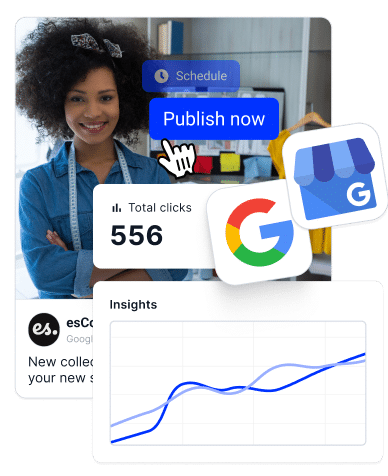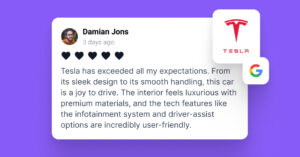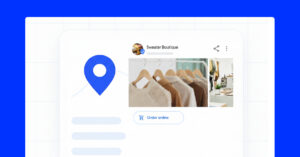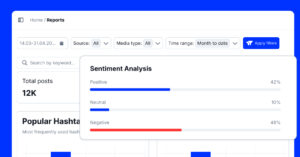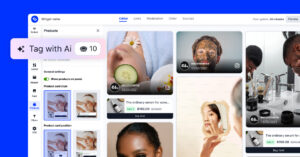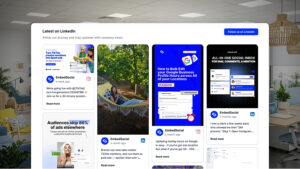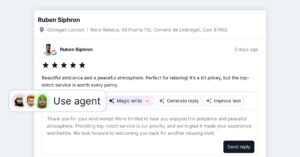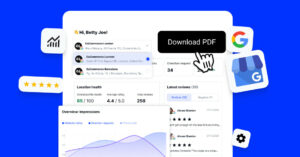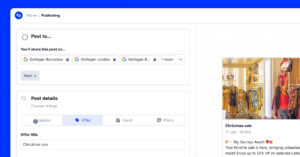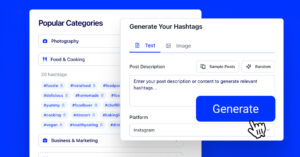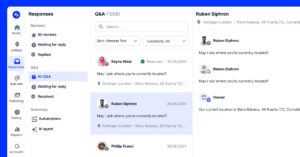Les marques et les entreprises savent aujourd'hui que le contenu généré par l'utilisateur (CGU) est un outil puissant qui peut susciter l'engagement, instaurer la confiance et rehausser votre marque.
À l'heure où tout le monde commence à s'appuyer sur le contenu authentique et relatable de ses clients pour réduire les coûts et atteindre un public, une gestion efficace du CGU devient essentielle. Vous ne me croyez pas ? Le CGU dans l'email marketing génère 78% de clics supplémentaires. Et ce n'est qu'un seul Statuts de l'UGC!
Qu'il s'agisse de collecter des photos sur les médias sociaux, d'encourager les clients à partager leurs commentaires ou de réutiliser le contenu pour des campagnes de marketing, il est essentiel de mettre en place un processus solide de gestion des CGU, car il permet de rationaliser votre stratégie de contenu.
Qu'est-ce que la gestion de l'UGC ?
Définition: La gestion du contenu généré par l'utilisateur (CGU) fait référence au processus de collecte, organiseret utiliser le contenu créé par les consommateursIl s'agit d'un contenu de marque, tel que des photos, des vidéos, des commentaires et des messages sur les médias sociaux. Au lieu de s'appuyer uniquement sur le contenu de marque, les entreprises peuvent exploiter l'authenticité et l'engagement des CGU pour améliorer leurs initiatives de marketing.
Pour les entreprises, l'UGC est inestimable car il peut établir la confiance, accroître la notoriété de la marque et fournir preuve socialece qui favorise l'engagement et les conversions.
En gérant efficacement l'UGC, les entreprises rationalisent leurs stratégies de marketing UGC, présentent des expériences clients authentiques et gardent le contrôle de leur récit.
Ci-dessous, je vous présente l'ensemble du processus de gestion de l'UGC, de la collecte à l'analyse, en vous proposant des mesures concrètes pour vous aider à exploiter tout le potentiel de l'UGC :
- Collection UGC
- Incitation à l'UGC
- Gestion des droits des CGU
- Gestion des actifs UGC
- Modération des CGU
- Réutilisation de l'UGC
- Analyse des CGU
Prêt à transformer vos clients en créateurs de contenu ? Plongeons dans l'aventure !
Comment collecter les CGU ?
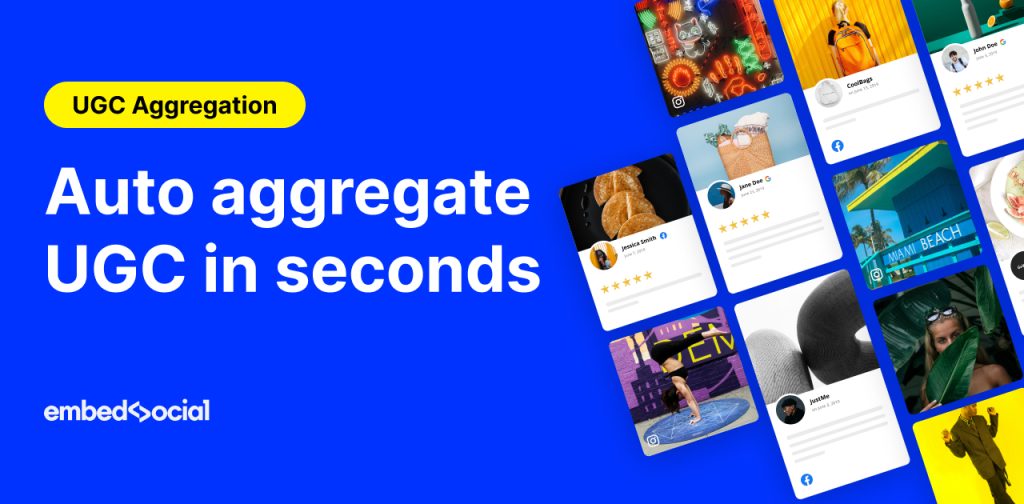
Quand la collecte de CGUPour ce faire, vous pouvez consulter les réseaux de médias sociaux où votre public s'engage avec vos marques, tels que les médias sociaux, les plateformes d'évaluation, les blogs et les forums, ou même votre équipe chargée de la satisfaction de la clientèle, qui a accès à des interviews et à des études de cas.
Les plateformes UGC comme EmbedSococial peuvent aider à collecter en quelques secondes tout ce contenu généré par les utilisateurs à partir de toutes les sources suivantes (et d'autres) :
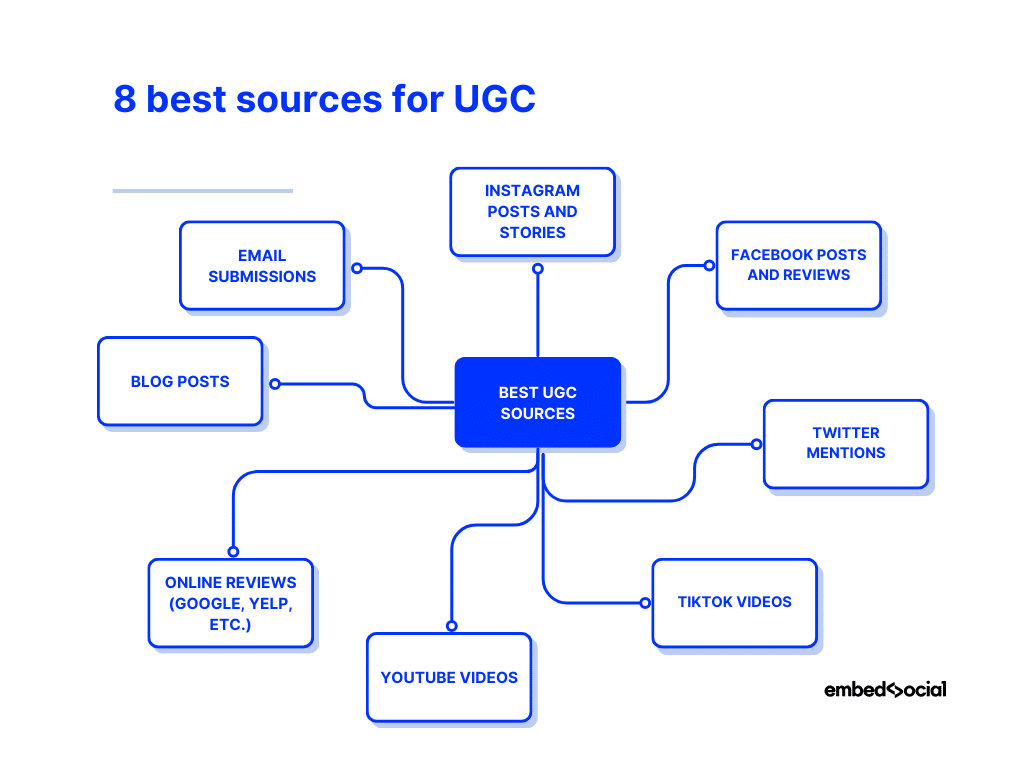
- Messages et histoires Instagram-suivre les hashtags de marque, surveiller les photos et vidéos marquées et demander du contenu directement aux utilisateurs par le biais de DM ou de commentaires ;
- Publications et commentaires sur Facebook-Utilisez la fonction de recherche de Facebook pour trouver les mentions de votre marque, configurez des alertes pour les tags de page et vérifiez les avis ;
- Mentions sur Twitter-Créez des alertes Twitter pour les mentions de la marque, les hashtags et les retweets, et utilisez des outils comme Hootsuite ou Sprout Social pour suivre les conversations pertinentes ;
- Vidéos TikTok-Suivez les hashtags et les défis de votre marque, et recherchez les mentions de votre marque dans la barre de recherche de TikTok pour recueillir du contenu généré par les utilisateurs ;
- Vidéos YouTubeRecherchez des vidéos mentionnant votre marque ou votre produit, abonnez-vous à des chaînes pertinentes et utilisez un système d'alerte par mot-clé pour découvrir de nouvelles vidéos ;
- Avis en ligne (Google, Yelp, etc.)-intégrer des outils tels que EmbedSocial ou Trustpilot pour obtenir automatiquement des avis sur les plates-formes et sur votre site web. Profil d'entreprise Google;
- Articles de blog-Créez des alertes Google ou utilisez des outils comme BuzzSumo pour trouver les articles de blog qui mentionnent votre marque, puis contactez les auteurs pour leur demander l'autorisation de les partager ;
- Envoi par courrier électronique-Encourager les clients à envoyer des photos, des témoignages ou des expériences par le biais de campagnes de courrier électronique et de formulaires intégrés à votre site web.
En combinant ces sources avec un suivi efficace et des stratégies de collecte de CGU, vous obtenez une mine de CGU précieux pour améliorer vos stratégies de marketing.
Vous pouvez ainsi gérer et réorienter sans effort les informations pertinentes. Exemples de CGU sur différents canaux, en suscitant l'engagement et en instaurant un climat de confiance avec votre public.
Comment inciter les utilisateurs à créer des CGU ?
Pour encourager votre public à créer du contenu généré par l'utilisateur, vous devez lui offrir quelque chose de précieux en retour, par exemple des récompenses tangibles, la reconnaissance de la marque et un accès exclusif. L'essentiel est d'aligner l'incitation sur les intérêts et les préférences de votre public.
Une méthode efficace consiste à organiser des concours ou des cadeaux. Par exemple, offrir un prix aux utilisateurs qui partagent des photos ou des vidéos d'eux en train d'utiliser votre produit est un moyen simple mais efficace d'obtenir plus d'UGC.
Réductions et points de fidélité fonctionnent également très bien, en particulier pour les marques de commerce électronique. Vous pouvez offrir une réduction sur le prochain achat à ceux qui partagent leur CGU.
En outre, la présentation du contenu des utilisateurs sur les pages des médias sociaux ou sur le site web de votre marque peut être un facteur de motivation important. Les gens aiment la reconnaissanceet leur donner une plateforme pour présenter leur créativité peut encourager une plus grande participation.
Rappelez-vous : plus l'incitation est personnalisée et pertinente, plus les utilisateurs seront motivés pour créer et partager des CGU.
Comment obtenir des droits sur les CGU avant de les publier ?

L'obtention des droits d'utilisation des CGU auprès de vos clients ou d'autres utilisateurs est une étape cruciale du processus de gestion des CGU. En effet, si vous n'obtenez pas les autorisations nécessaires, vous risquez de vous exposer à des problèmes juridiques.
La meilleure façon de gérer les droits sur les CGU est de communiquer clairement avec l'autorité compétente. Créateurs de CGU. Vous devez toujours demander la permission par DM, courriel ou commentaires, en s'assurant qu'ils comprennent comment et où leur contenu sera utilisé.
Les considérations juridiques impliquent respecter les lois sur la propriété intellectuelle et en veillant à ce que vous ayez consentement explicite du créateur. En outre, vous devez toujours conserver une trace des autorisations reçues, en particulier lorsque vous utilisez le contenu à des fins commerciales.
Vous pouvez procéder de deux manières pour obtenir des droits UGC :
- Utiliser des modèles juridiques pour les communiqués de presse et les contrats-Ces documents décrivent les conditions d'utilisation et protègent à la fois votre marque et le créateur, ou
- S'abonner à un outil doté d'une fonction de demande de droits sur les CGU-Ces outils simplifient le processus de gestion des droits en automatisant les demandes d'autorisation, en suivant le statut de la demande et en stockant tous les accords de consentement en un seul endroit.
Consultez notre Gestion des droits des CGU pour en savoir plus sur l'obtention des droits sur le contenu généré par l'utilisateur de quelqu'un d'autre. De plus, vous obtiendrez les modèles et les outils nécessaires pour y parvenir.
Il couvre tous les aspects, des obligations légales aux étapes pratiques de l'acquisition et de la gestion des droits d'utilisation, pour vous aider à éviter les pièges tout en maximisant la valeur des CGU.
Comment gérer, stocker et rechercher les ressources UGC ?
La gestion efficace des CGU nécessite un système bien organisé pour stocker et récupérer le contenu, et la meilleure approche consiste à centraliser tous les CGU sur une seule plateforme.
De cette façon, vous pouvez classer, étiquetteet trier le contenu en fonction de vos besoins, ce qui vous permet de rester organisé et de localiser plus facilement des CGU spécifiques lorsque vous en avez besoin pour des campagnes de marketing, des plateformes de médias sociaux ou d'autres stratégies de contenu.
Pour des solutions efficaces de stockage des CGU, envisagez d'utiliser diverses les plates-formes de stockage basées sur l'informatique en nuageou, mieux encore, un Plate-forme complète d'UGC qui recueille, stocke et affiche les CGU, comme EmbedSocial, qui vous aide à faire tout ce qui suit rapidement et facilement :
- Intégration transparente avec tous les principaux canaux de médias sociaux-vous pouvez rassembler sans effort des messages et des photos, Vidéos UGC, des critiques, des commentaires et bien plus encore ;
- Tableau de bord des mentions dans les médias sociaux et des commentaires des utilisateurs-vous pouvez contrôler, modérer et hiérarchiser tous les CGU que vous collectez à partir d'un seul endroit ;
- Intégrer des widgets interactifs centrés sur le client-choisir parmi différents modèles préétablis pour intégration des examensIl s'agit de vidéos, de formulaires ou de vidéos TikTok, d'histoires, de hashtags et de flux Instagram. Widgets pour les avis de Google avec des vidéos et des photos, et plus encore ;
Une fois que vous avez connecté vos comptes sociaux et ajouté vos sources UGC, EmbedSocial obtient tout le contenu de vos médias sociaux, que vous pouvez utiliser à tout moment.
En outre, la plateforme intégrer automatiquement du contenu frais à partir de vos sources et l'organiser par date, plateforme, tags utilisateur, mots-clés, etc.
Comment utiliser l'IA pour étiqueter et organiser automatiquement les messages ?
Pour faciliter la recherche de votre contenu, mettre en œuvre un système cohérent de dénomination et d'étiquetage. Par exemple, marquez les CGU par type de produit, par lieu ou par campagne spécifique.
Ainsi, lorsque vous êtes prêt à réutiliser votre contenu, vous pouvez rapidement filtrer et rechercher les ressources en fonction de vos besoins, ce qui vous permet de gagner un temps précieux et d'économiser des ressources.
Toutefois, vous pouvez également éviter ce processus manuel de marquage de chaque message en utilisant la fonction Le site Web d'EmbedSocial Fonction d'enrichissement de l'IA, qui attribue automatiquement des étiquettes et des catégories à tous les messages UGC que vous collectez. L'utilisation de cette fonction ne nécessite que quelques étapes :
Étape 1 : Accéder à la section "Moniteur
Après avoir connecté toutes vos sources de médias sociaux dans EmbedSocial, rendez-vous dans la section Section "Moniteur (dans le menu de gauche) :
Étape 2 : Sélectionnez les messages que vous souhaitez catégoriser
Ensuite, il vous suffit de sélectionner tous les posts que vous souhaitez enrichir via notre outil AI.
Le ‘Options en vrac’ Un menu déroulant apparaîtra lorsque vous commencerez à le faire, et il vous permettra également de ‘Marquer les 10 derniers messages’ afin d'économiser du temps et des efforts :
Vous pouvez soit cocher chaque article pertinent et cliquer sur ‘Étiqueter avec l'IA’ ou appuyez sur Organiser les rangs en haut de la page pour enrichir automatiquement les 10 derniers messages que vous avez collectés :
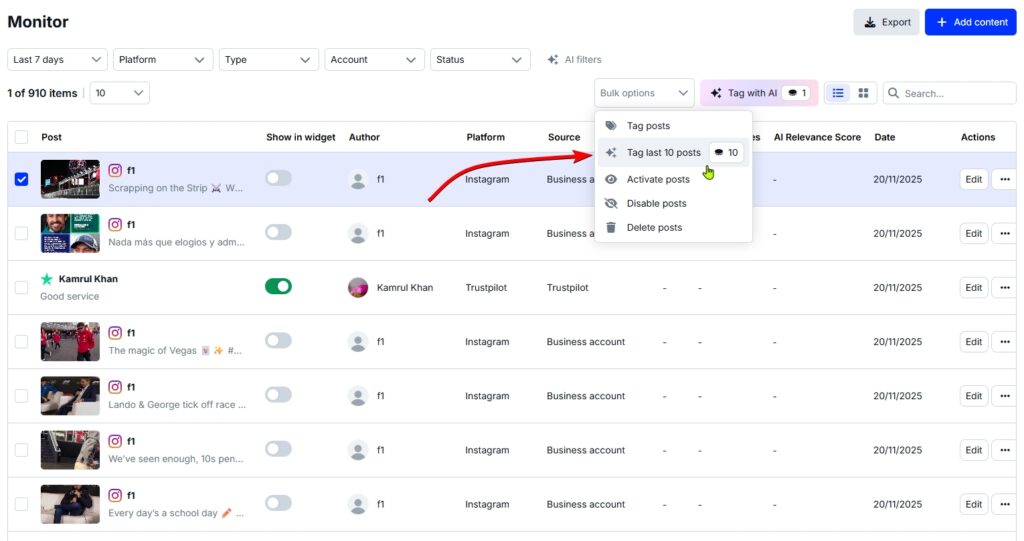
Remarque : Vous dépenserez 1 crédit AI pour 1 poste. Par conséquent, si vous enrichissez 10 messages automatiquement, vous utiliserez 10 de vos crédits AI. Vérifiez donc vos crédits avant d'utiliser cette fonction.
Étape 3 : Exécuter l'outil AI pour attribuer automatiquement des étiquettes et des catégories
Une fois que vous aurez terminé, vous obtiendrez quelque chose comme la liste suivante, qui comprend jusqu'à 5 balises pour chaque article et l'une des catégories suivantes:
- Rétroaction positive
- Plainte
- Éloge de la marque
- Chef de file potentiel
- Promotionnel
- Bruit
- Question
- Autres

Nous prévoyons également d'ajouter des colonnes supplémentaires à l'avenir, telles que sentiment, résumé et action recommandée.
Remarque : Il va sans dire que vous ne pouvez terminer le processus ci-dessus qu'après avoir créer votre compte EmbedSocial et en connectant toutes vos sources de médias sociaux.
Comment modérer les messages dans vos widgets UGC ?
Vous avez un contrôle total sur vos CGU grâce à l'éditeur de widgets situé sous la rubrique Onglet "Modération:
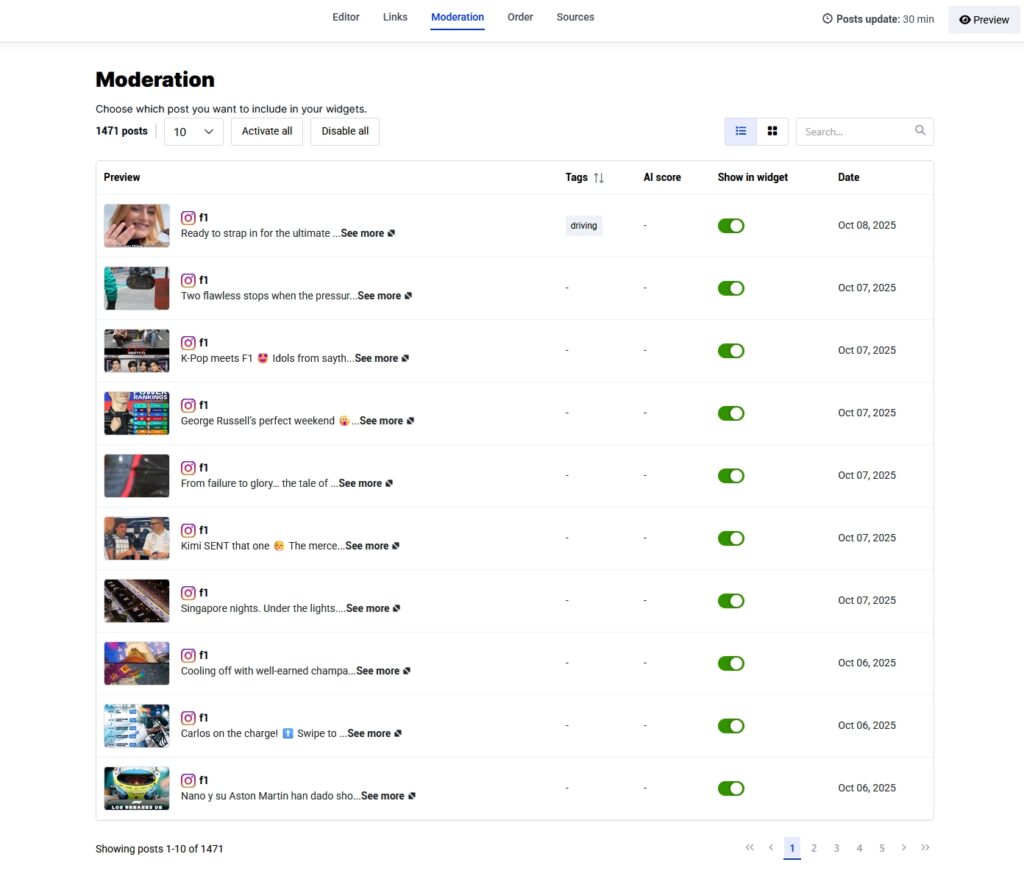
Comme vous pouvez le voir, vous pouvez activer ou désactiver des messages spécifiques afin d'organiser votre alimentation.
Cela dit, nous proposons également un meilleur moyen de modérer automatiquement tous vos messages grâce à l'intelligence artificielle.
Comment utiliser l'évaluation et la modération par l'IA de vos CGU ?
Vous pouvez lancer le processus par le biais de l'option ‘Onglet ’Filtres" dans votre page source juste après l'avoir connecté :
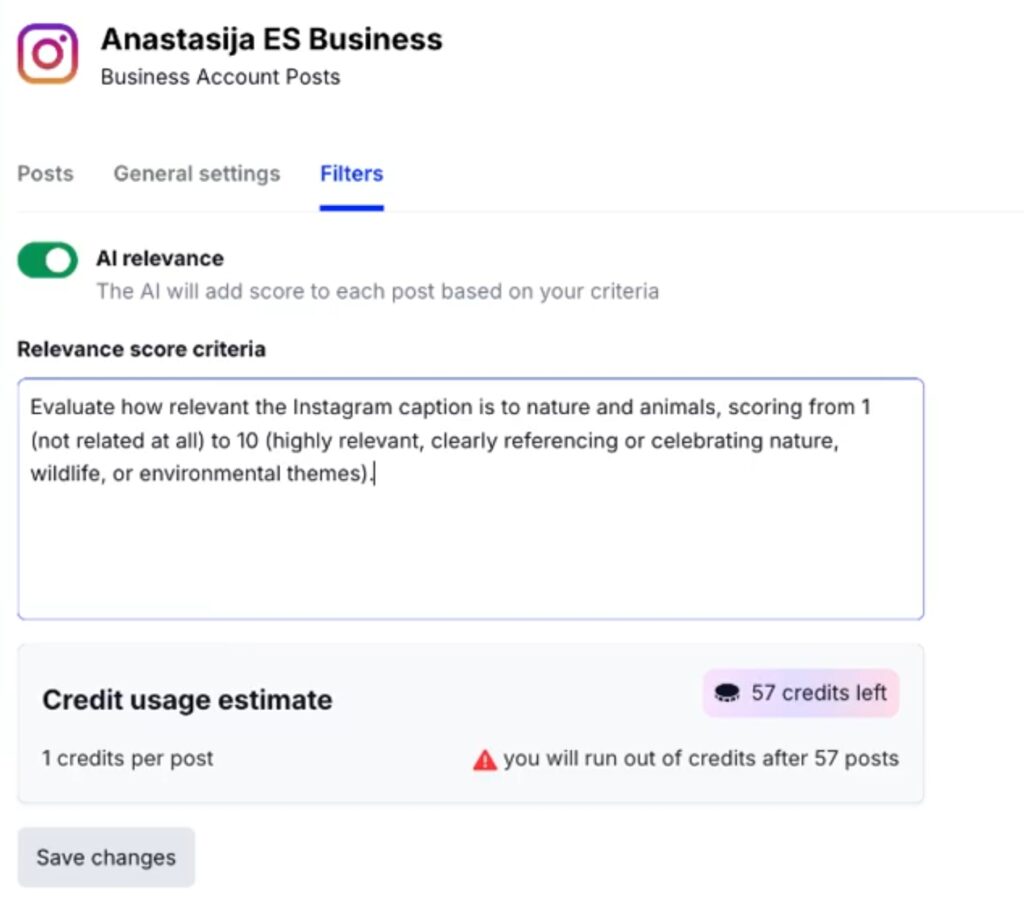
Une fois que vous avez défini vos filtres, notre plateforme commencera à ajouter de nouveaux messages à votre widget en fonction de ceux-ci, à condition qu'ils répondent à un score de pertinence prédéfini.
Dans l'exemple suivant, j'ai créé un fichier filtre de pertinence minimale de 76%, ce qui signifie, seuls les messages marqués d'un score égal ou supérieur à celui-ci seront affichés dans mon widget.
Comme vous pouvez le constater, pour l'instant, un seul message répond à ce critère :
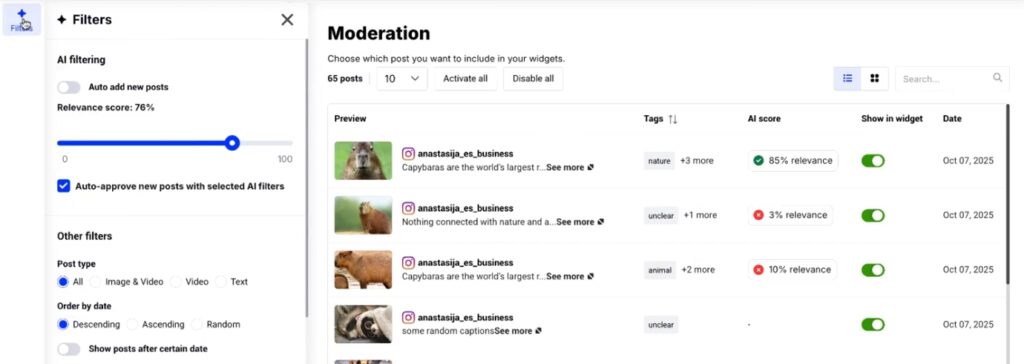
Comment réutiliser l'UGC pour le marketing et les ventes grâce aux widgets UGC ?
Réutilisation des données générées par les influenceurs et le contenu généré par les utilisateurs sur différents canaux de marketing est l'un des meilleurs moyens d'en maximiser la valeur.
Par exemple, les CGU peuvent être transformés en puissants atouts marketing, que ce soit pour des posts sur les médias sociaux, des campagnes d'e-mailing, des pages de produits ou même des publicités. Cela dit, vous devez maintenir l'authenticité lorsque vous alignez votre contenu sur vos objectifs.
Une bonne pratique consiste à intégrer le CGU sur votre site webLa preuve sociale, en particulier sur les pages produits, où les acheteurs potentiels peuvent voir de vraies photos de clients et des commentaires. Ce type de preuve sociale permet d'instaurer la confiance et peut améliorer considérablement les conversions.
En outre, le CGU peut être réutilisé pour des publicités payantes, car les témoignages authentiques et les photos de clients sont souvent plus performants que le contenu de marque traditionnel.
Enfin, vous pouvez intégrer votre CGU dans votre courriel marketing - en présentant des témoignages de clients ou des photos dans vos courriels et vos lettres d'information, vous stimulez l'engagement et les clics.
Voici quelques exemples de réutilisation de CGU avec l'aide de EmbedSocial:
ASUS - #DesignYouCanFeel
Ce géant de la technologie a décidé de lancer une campagne UGC pour promouvoir sa dernière gamme ASUS Zenbook, car il pense à juste titre que le contenu généré par les utilisateurs est le meilleur moyen de mettre en valeur l'aspect pratique, l'utilité et la valeur de la dernière offre d'ASUS :
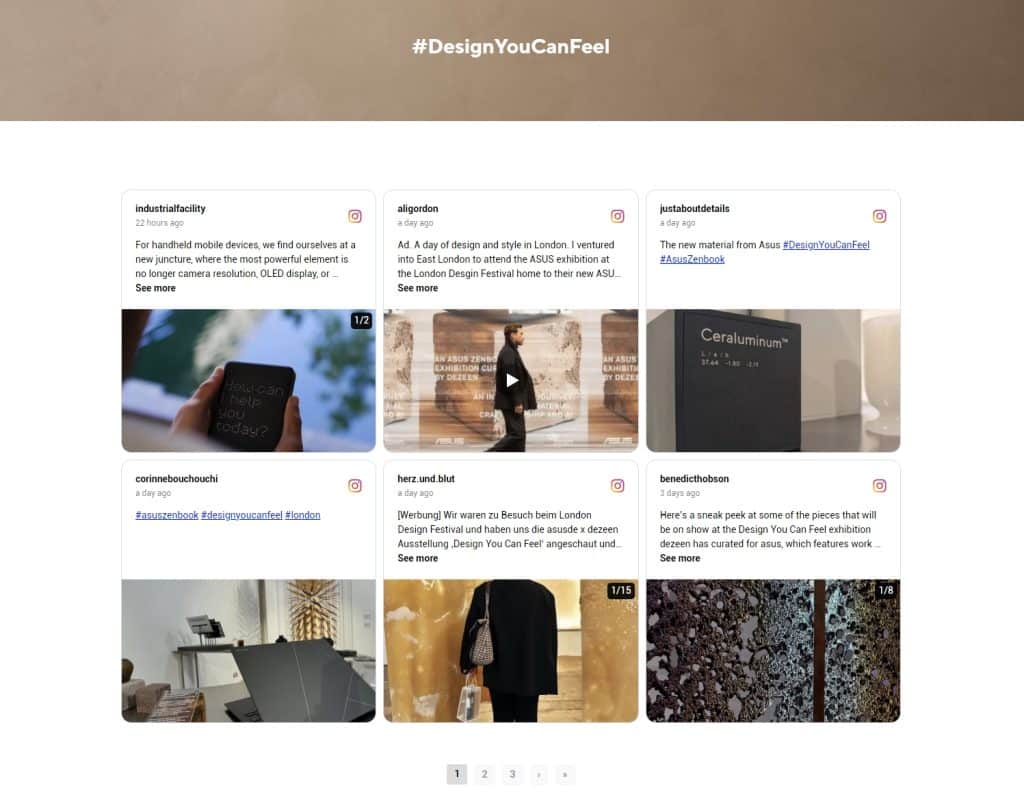
Comme vous pouvez le constater, la mise en page du flux est parfaite pour présenter les expériences des clients avec le Zenbook, car chaque carte est une histoire à part entière, en particulier lorsque vous cliquez dessus.
Washingborough Hall - #WashyHallMoments
Le Washingborough Hall, un magnifique hôtel situé à Lincoln, au Royaume-Uni, présente les expériences vécues par ses clients et visiteurs, qu'il s'agisse de prendre le thé l'après-midi ou de se marier lors d'une magnifique cérémonie de mariage :
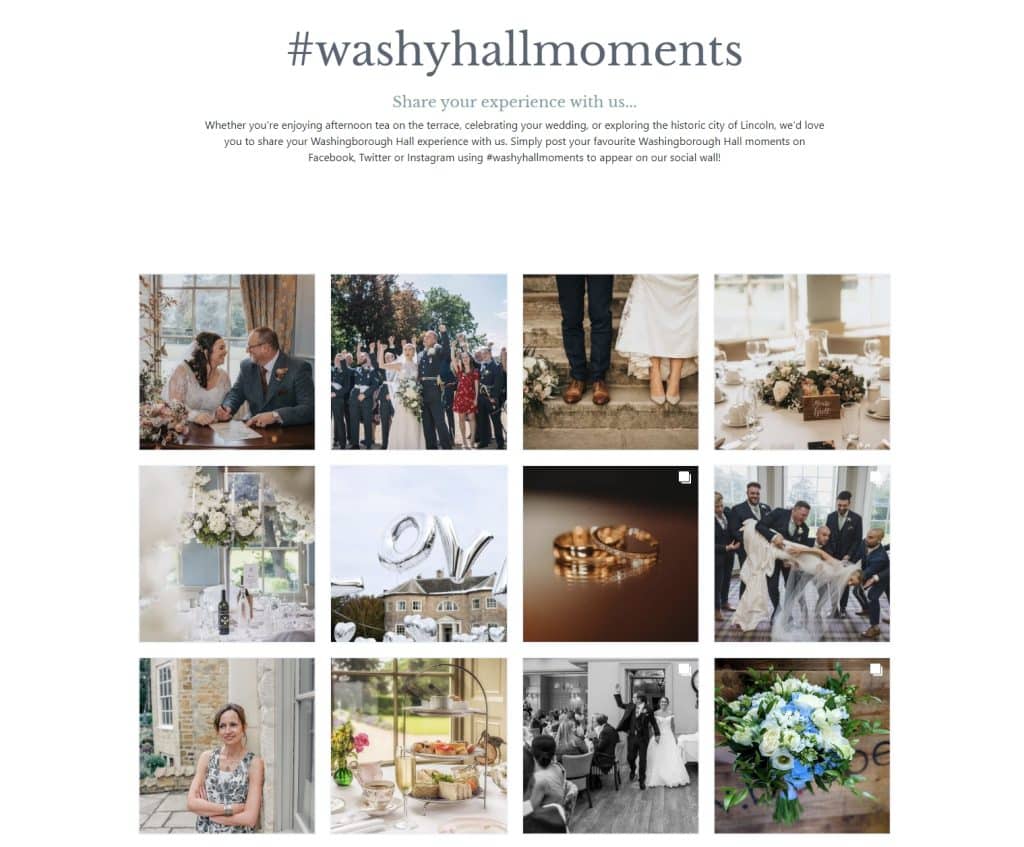
Les utilisateurs sont seulement invités à partager des photos de leur expérience en utilisant le tag #washyhallmoments, que l'hôtel réutilise ensuite dans un widget UGC captivant.
En fin de compte, L'UGC dans le commerce électronique est particulièrement efficace car les clients peuvent voir le produit dans le monde réel lorsqu'ils font leurs achats.
Lire la suite :
Comment analyser l'UGC pour en tirer des enseignements ?
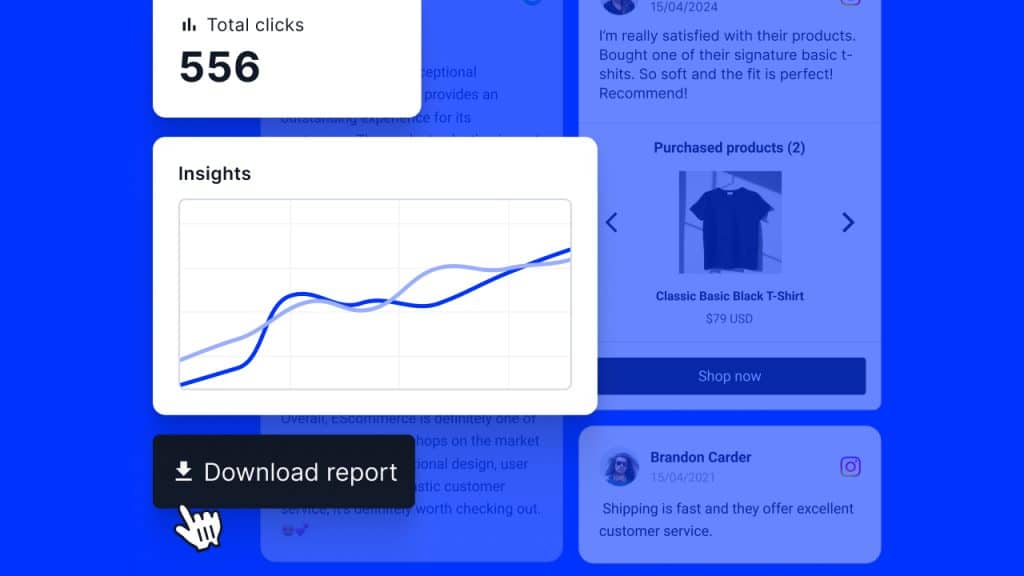
L'analyse du contenu généré par les utilisateurs (CGU) est essentielle pour comprendre l'impact qu'il a sur votre marque et contribue à vos objectifs marketing globaux.
La première étape consiste à mesurer l'efficacité de l'UGC à l'aide d'indicateurs de performance clés tels que les taux d'engagement, la portée, les taux de conversion et l'analyse des sentiments.
En évaluant la fréquence d'engagement des utilisateurs avec le CGU par rapport au contenu de marque, vous pouvez mesurer son influence sur les décisions des clients et la perception de la marque.
Toutefois, pour analyser efficacement les CGU, les entreprises doivent utiliser des outils tiers tels que Google Analytics ou des fournisseurs de CGU payants disposant d'outils d'analyse et de gestion des CGU. écoute sociale des outils. Ainsi, vous obtiendrez des informations sur des paramètres tels que les likes, les partages, les commentaires et la portée.
Vous pouvez également utiliser Analyse des sentiments par l'IA des outils comme EmbedSocial, Brandwatch ou Mention pour suivre le ton autour de votre marque et comprendre ce que votre public pense de vous.
Enfin, les tests A/B constituent une autre méthode efficace pour recueillir des informations. Par exemple, vous pouvez comparer les performances d'un CGU dans une campagne publicitaire à celles d'un contenu de marque, afin de déterminer lequel des deux suscite le plus d'engagement ou de conversions.
En fin de compte, en combinant ces méthodes et outils, les entreprises peuvent recueillir des informations précieuses pour affiner leurs stratégies UGC et maximiser leur impact.
Les pièges à éviter dans la gestion de l'UGC
La gestion du contenu généré par les utilisateurs comporte son lot de défis. Voici donc quelques pièges à éviter et des conseils pour les surmonter :

- Défaut d'obtention des droits appropriés - veillez à obtenir l'autorisation explicite du créateur du contenu avant d'utiliser son CGU afin d'éviter tout problème juridique ;
- L'authenticité de l'UGC négligée - éviter d'éditer ou de modifier lourdement le CGU, car cela peut en réduire l'authenticité et l'impact. Restez fidèle au contenu original pour maintenir la confiance ;
- Contrôle incohérent des CGU - suivre et examiner régulièrement les soumissions de CGU afin de rester au fait des contenus qui mentionnent votre marque. Utilisez des outils de gestion des CGU pour rationaliser ce processus ;
- Ignorer les CGU négatifs - tous les CGU ne sont pas positifs et les éviter peut nuire à votre marque. Abordez les contenus négatifs de manière constructive pour montrer la réactivité de votre marque ;
- Ne pas inciter correctement les utilisateurs - offrir des récompenses mineures peut entraîner une faible participation. Adaptez vos incitations aux intérêts de votre public afin d'encourager les soumissions de qualité ;
- Stockage désorganisé des ressources du CGU - un stockage inadéquat du CGU rend difficile sa recherche ultérieure. Utilisez des systèmes de stockage centralisés et des méthodes d'étiquetage cohérentes pour faciliter la recherche ;
- Absence de suivi des performances des CGU - Analysez les performances de votre CGU pour savoir ce qui fonctionne en suivant l'efficacité de vos campagnes de CGU et en prenant des décisions fondées sur des données.
En évitant ces pièges courants, vous apprendrez à gérer efficacement le CGU et à faire en sorte qu'il continue à vous apporter de la valeur et à vous faire économiser des fonds de marketing.
Tirez parti de l'UGC dès aujourd'hui
Aujourd'hui, tout responsable de marque, responsable marketing, propriétaire d'entreprise ou autre partie intéressée a compris que le contenu généré par l'utilisateur est plus qu'une tendance.
Elle est devenue une méthode essentielle et très rentable pour les entreprises qui cherchent à se faire connaître et à établir un lien authentique avec leur public.
Cependant, la gestion efficace du CGU nécessite une stratégie solide qui englobe la collecte de contenu, l'incitation des utilisateurs, l'obtention des droits appropriés et l'organisation de votre contenu CGU pour une réutilisation facile lorsque le besoin (ou l'idée marketing) se fait sentir.
Qu'il s'agisse de réutiliser le contenu pour le marketing ou d'utiliser les analyses pour affiner votre stratégie, la gestion des CGU vous aide à créer une expérience de marque axée sur le client.
Il s'agit donc de tirer parti de la Meilleures pratiques en matière de CGU Ce guide vous permettra d'exploiter tout le potentiel de votre CGU, de construire une identité de marque, d'améliorer l'engagement et de stimuler les ventes. N'oubliez cependant pas d'utiliser les bons outils pour maximiser l'impact de votre CGU, comme une plateforme complète de CGU telle qu'EmbedSocial.
Prêt à faire passer votre gestion du CGU au niveau supérieur ? Mettez en œuvre ces stratégies dès aujourd'hui et faites de vos clients vos meilleurs créateurs de contenu !
FAQ sur la gestion de l'UGC
Qu'est-ce que l'UGC et comment fonctionne-t-elle ?
Le contenu généré par les utilisateurs (CGU) désigne toute forme de contenu - photos, vidéos, commentaires ou messages sur les médias sociaux - créé par les consommateurs et non par les marques. Il exploite les expériences authentiques des clients et peut être partagé en ligne pour renforcer la crédibilité de la marque et l'engagement des clients.
Qu'est-ce que la gestion des contenus générés par les utilisateurs ?
La gestion du contenu généré par les utilisateurs comprend les processus et les outils utilisés pour collecter, stocker, organiser et réutiliser le CGU de manière efficace. Cette gestion est cruciale pour garder le contrôle de la narration de votre marque tout en maximisant l'impact de votre CGU.
Quel est un exemple de contenu généré par l'utilisateur ?
Un exemple d'UGC est celui d'un client qui partage une photo de lui en train d'utiliser un produit sur Instagram, en étiquetant la marque et en ajoutant un commentaire personnel. Ce type de contenu peut être partagé par la marque sur ses propres plateformes, ajoutant ainsi de l'authenticité à ses efforts de marketing.
Comment surveiller les CGU ?
Le suivi de l'UGC implique l'utilisation d'outils et de stratégies pour suivre et analyser le contenu créé par les utilisateurs des médias sociaux qui mentionnent votre marque, ce qui implique souvent de mettre en place des alertes sur les médias sociaux, d'examiner régulièrement les hashtags et d'être actif sur les médias sociaux et les plates-formes d'évaluation.
